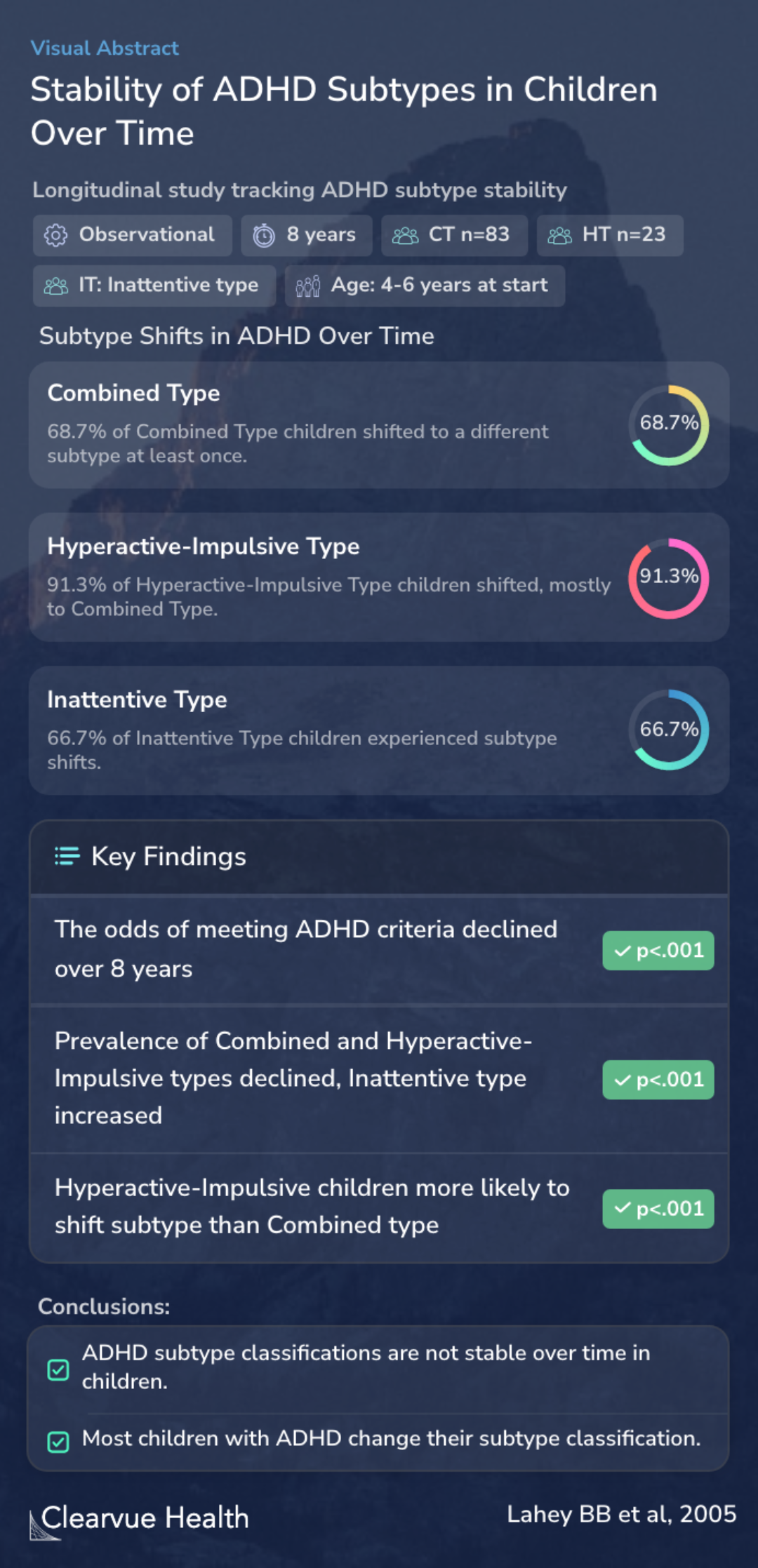Instability of the DSM-IV Subtypes of ADHD from preschool through elementary school
Stability of ADHD Subtypes in Children Over Time
Lahey BB, Pelham WE, Loney J, Lee SS, Willcutt E

Objectives
The study set out to examine the stability of ADHD subtypes as defined by the DSM-IV. Specifically, the research aimed to determine if these subtypes remain consistent over time.The study's objective was to validate the consistency of these subtypes, which could impact how we understand and approach ADHD in children.
The DSM-IV definition of attention-deficit/hyperactivity disorder (ADHD) distinguished 3 subtypes that had not been extensively studied. To determine whether the ADHD subtypes are stable enough over time to be valid.
Methods
The research method involved a longitudinal study, meaning it followed the same group of children over a long period - eight years in this case. The participants were 118 children, aged between 4 and 6 years, who were diagnosed with ADHD according to the DSM-IV criteria. This approach allowed the researchers to observe how the subtypes of ADHD evolved or remained stable over time in a real-world setting.
Longitudinal study with a greater-than 89% retention rate in 7 assessments over 8 years. Volunteer sample of 118 4- to 6-year-olds who met DSM-IV criteria for ADHD, including impairment in 2 settings in at least 1 assessment.
Results
Over the eight-year period, the researchers found interesting patterns in ADHD subtypes. They observed that most children persisted with ADHD, but the subtypes they belonged to changed over time. For instance, children initially classified in the predominantly hyperactive-impulsive subtype (HT) were more likely to shift to the combined subtype (CT) in later assessments. This finding suggests that the ADHD subtypes, as currently defined, may not be stable over long periods in a child's development.
The number of children who met criteria for ADHD declined over time, but most persisted. Children who met criteria for the combined subtype (CT, n = 83) met criteria for ADHD in more subsequent assessments than children in the predominantly hyperactive-impulsive subtype (HT, n = 23). Thi...
Conclusions
The conclusions of the study indicate that ADHD subtypes, as classified in younger children, are not entirely stable over time. The study suggests that continuous ratings of symptoms, rather than strict subtype classifications, might be a more practical approach in diagnosing and understanding ADHD in children.
In younger children, the CT and IT may be stable enough to segregate groups for research, but they seem too unstable for use in the clinical assessment of individual children. Children rarely remain in the HT classification over time; rather, they sometimes desist from ADHD but mostly sh...
Key Takeaways
Context
For readers interested in further exploring the nuances of ADHD, the study by Gaub M et al., conducted in 1997, offers valuable insights. Their research delved into how different ADHD subtypes affect behavior, academics, and social functioning in school children. Each subtype presented unique challenges, providing a deeper understanding of the disorder's impact in educational settings. This study could be particularly enlightening for those wanting to understand the specific challenges each ADHD subtype poses.
Another compelling study for further reading is by Pasini et al., from 2007. This research investigated the effects of ADHD on executive functions and attention across different subtypes. It particularly highlighted the deficits in boys with ADHD, especially in those with inattentive or combined subtypes. This study helps us understandthe unique attentional and executive function challenges faced by boys with different ADHD subtypes, complementing the broader context of ADHD research.